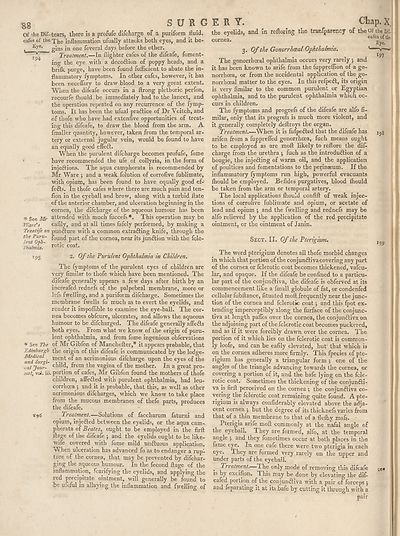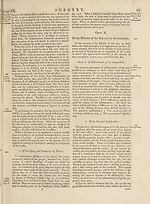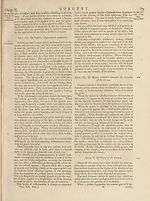Encyclopaedia Britannica, or, a Dictionary of arts, sciences, and miscellaneous literature : enlarged and improved. Illustrated with nearly six hundred engravings > Volume 20, SUI-ZYM
(96) Page 88
Download files
Complete book:
Individual page:
Thumbnail gallery: Grid view | List view

BS
of ihe Dif-
eafes of the
Eye.
m
SURGERY.
Chap. X
tears, there is a pfofufe diicharge of a puriform fluid.
The inflammation ufually attacks both eyes, and it be¬
gins in one feveral days before the other.
Treatment.—In {lighter cafes of the difeafe, foment¬
ing the eye with a decoflion of poppy heads, and a
briik purge, have been found fufficient to abate the in¬
flammatory fymptoms. In other cafes, however, it has
been neceffary to draw blood to a very great extent.
When the difeafe occurs in a ftrong plethoric perfon,
recourfe fhould be immediately had to the lancet, and
the operation repeated on any recurrence of the fymp¬
toms. It has been the ufua] practice of Dr Veitch, and
of thofe who have had extenfive opportunities of treat¬
ing this difeafe, to draw the blood from the arm. A
fmaller quantity, however, taken from the temporal ar¬
tery or external jugular vein, would be found to have
an equally good effedl.
When the purulent difcharge becomes profufe, fome
have recommended the ufe of collyria, in the form of
injedlions. The aqua camphorata is recommended by
Mr Ware 5 and a weak folution of corrofive fublimate,
with opium, has been found to have equally good ef-
fe£ts. In thofe cafes where there are much pain and ten-
lion in the eyeball and brow, along with a turbid date
of the anterior chamber, and ulceration beginning in the
cornea, the difcharge of the aqueous humour has been
attended with much fuccefs *. This operation may be
eafily, and at all times fafely performed, by making a
punfture with a common extra£ling knife, through the
found part of the cornea, near its junction with the fcle-
rotic coat.
2. Of the Purulent Ophthalmia in Children.
The fymptoms of the purulent eyes of children are
very flmilar to thofe which have been mentioned. The
difeafe generally appears a few days after birth by an
increafed rednefs of the palpebral membrane, more or
lefs fwelling, and a puriform difcharge. Sometimes the
membrane fwells fo much as to evert the eyelids, and
render it impoflible to examine the eye-ball. The cor¬
nea becomes obfcure, ulcerates, and allows the aqueous
humour to be difcharged. The difeafe generally affefts
both eyes. From what we know of the origin of puru¬
lent ophthalmia, and from fome ingenious obfervations
* See The of Mr Gibfon of Manchefter,* it appears probable, that
Edinburgh the origin of this difeafe is communicated by the lodge-
^mtsul i ment an acr*moni°us difcharge upon the eyes of the
jouf-' child, from the vagina of the mother. In a great pro-
nal, vul. iii. portion of cafes, Mr Gibfon found the mothers of thofe
children, affedled with purulent ophthalmia, had leu-
corrhoea •, and it is probable, that this, as well as other
acrimonious difcbarges, which we know to take place
from the mucous membranes of thefe parts, produces
the difeafe.
-«r96 Treatment.—Solutions of faccharum faturni and
opium, injedled between the eyelids, or the aqua cam-,
phorata of Beates, ought to be employed in the firft
ilage of the difeafe j and the eyelids ought to be like-
wufe covered with fome mild unftuous application.
When ulceration has advanced fo as to endanger a rupl
ture of the cornea, that may be prevented by difehar-
ging the aqueous humour. In the fecond ftage of the
inflammation, fcarifying the eyelids, and applying the
red precipitate ointment, will generally be found to
be ufeful in allaying the inflammation and fwelling of
the eyelids, and in reftoring tlie tranfparency of the of the Dif.
J eafes of the
cornea.
* See Mr
Ware's
Treatife on
the Puru¬
lent Oph¬
thalmia.
IPS
3. Of the Gonorrhoeal Ophthalmia. v
The gonorrhoeal ophthalmia occurs very rarely $ and
it has been known to arife from the liippreflion of a go¬
norrhoea, or from the accidental application of the go¬
norrhoeal matter to the eyes. In this refpeft, its origin
is very fimilar to the common purulent or Egyptian
ophthalmia, and to the purulent ophthalmia which oc¬
curs in children.
The fymptoms and progrefs of the difeafe are alfo fi¬
milar, only that its progrefs is much more violent, and
it generally completely deftroys the organ.
Treatment.—When it is fufpefted that the difeafe has
arifen from a fupprefled gonorrhoea, fuch means ought
to be employed as are moft likely to rellore the dif¬
charge from the urethra $ fuch as the introduction of a
bougie, the injeCling of warm oil, and the application
of poultices and fomentations to the perinaeum. If the
inflammatory fymptoms run high, powerful evacuants
(hould be employed. Befides purgatives, blood fhould
be taken from the arm or temporal artery.
The local applications fliould confifl of weak injec¬
tions of corrofive fublimate and opium, or acetate of
lead and opium •, and the fwelling and rednefs may be
alfo relieved by the application of the red precipitate
ointment, or the ointment of Janin.
Sect. II. Of the Pterigium.
The word pterigium denotes all thofe morbid changes
in which that portion of the conjunCliva covering any part
of the cornea or fclerotic coat becomes thickened, vafcu-
lar, and opaque. If the difeafe be confined to a particu¬
lar part of the conjun&iva, the difeafe is obferved at its
commencement like a fmall globule of fat, or condenfed
cellular fubftance, fituated moft. frequently near the junc¬
tion of the cornea and fclerotic coat; and this fpot ex¬
tending imperceptibly along the furface of the conjunc¬
tiva at length pafles over the cornea, the conjunfliva on
the adjoining part of the fclerotic coat becomes puckered,
and as if it were forcibly drawn over the cornea. The
portion of it which lies on the fclerotic coat is common¬
ly loofe, and can be eafily elevated, but that which is
on the cornea adheres more firmly. This fpecies of pte¬
rigium has generally a triangular form •, one of the
angles of the triangle advancing towards the cornea, or
covering a portion of it, and the bafe lying on the fcle¬
rotic coat. Sometimes the thickening of the conjundli-
va is firft perceived on the cornea ; the conjunctiva co¬
vering the fclerotic coat remaining quite found. A pte¬
rigium is always confiderably elevated above the adja¬
cent cornea *, but the degree of its thicknefs varies from
that °f a .thin, membrane to that of a flelby mafs.
Pterigia arife moft commonly at the nafal angle of
the eyeball. They are formed, alfo, at the temporal
angle j and they fometimes occur at both places in the
fame eye. In one cafe there were two pterigia in each
eye. Ihey are formed very rarely on the upper and
under parts of the eyeball.
Treatment.— Ihe only mode of removing this diftafe
is by excifion. I his may be done by elevating the dif-
eafed poition of the conjunCliva with a pair of forceps j
and feparating it at its bafe by cutting it through with a
pair
Eye.
197
198
199
of ihe Dif-
eafes of the
Eye.
m
SURGERY.
Chap. X
tears, there is a pfofufe diicharge of a puriform fluid.
The inflammation ufually attacks both eyes, and it be¬
gins in one feveral days before the other.
Treatment.—In {lighter cafes of the difeafe, foment¬
ing the eye with a decoflion of poppy heads, and a
briik purge, have been found fufficient to abate the in¬
flammatory fymptoms. In other cafes, however, it has
been neceffary to draw blood to a very great extent.
When the difeafe occurs in a ftrong plethoric perfon,
recourfe fhould be immediately had to the lancet, and
the operation repeated on any recurrence of the fymp¬
toms. It has been the ufua] practice of Dr Veitch, and
of thofe who have had extenfive opportunities of treat¬
ing this difeafe, to draw the blood from the arm. A
fmaller quantity, however, taken from the temporal ar¬
tery or external jugular vein, would be found to have
an equally good effedl.
When the purulent difcharge becomes profufe, fome
have recommended the ufe of collyria, in the form of
injedlions. The aqua camphorata is recommended by
Mr Ware 5 and a weak folution of corrofive fublimate,
with opium, has been found to have equally good ef-
fe£ts. In thofe cafes where there are much pain and ten-
lion in the eyeball and brow, along with a turbid date
of the anterior chamber, and ulceration beginning in the
cornea, the difcharge of the aqueous humour has been
attended with much fuccefs *. This operation may be
eafily, and at all times fafely performed, by making a
punfture with a common extra£ling knife, through the
found part of the cornea, near its junction with the fcle-
rotic coat.
2. Of the Purulent Ophthalmia in Children.
The fymptoms of the purulent eyes of children are
very flmilar to thofe which have been mentioned. The
difeafe generally appears a few days after birth by an
increafed rednefs of the palpebral membrane, more or
lefs fwelling, and a puriform difcharge. Sometimes the
membrane fwells fo much as to evert the eyelids, and
render it impoflible to examine the eye-ball. The cor¬
nea becomes obfcure, ulcerates, and allows the aqueous
humour to be difcharged. The difeafe generally affefts
both eyes. From what we know of the origin of puru¬
lent ophthalmia, and from fome ingenious obfervations
* See The of Mr Gibfon of Manchefter,* it appears probable, that
Edinburgh the origin of this difeafe is communicated by the lodge-
^mtsul i ment an acr*moni°us difcharge upon the eyes of the
jouf-' child, from the vagina of the mother. In a great pro-
nal, vul. iii. portion of cafes, Mr Gibfon found the mothers of thofe
children, affedled with purulent ophthalmia, had leu-
corrhoea •, and it is probable, that this, as well as other
acrimonious difcbarges, which we know to take place
from the mucous membranes of thefe parts, produces
the difeafe.
-«r96 Treatment.—Solutions of faccharum faturni and
opium, injedled between the eyelids, or the aqua cam-,
phorata of Beates, ought to be employed in the firft
ilage of the difeafe j and the eyelids ought to be like-
wufe covered with fome mild unftuous application.
When ulceration has advanced fo as to endanger a rupl
ture of the cornea, that may be prevented by difehar-
ging the aqueous humour. In the fecond ftage of the
inflammation, fcarifying the eyelids, and applying the
red precipitate ointment, will generally be found to
be ufeful in allaying the inflammation and fwelling of
the eyelids, and in reftoring tlie tranfparency of the of the Dif.
J eafes of the
cornea.
* See Mr
Ware's
Treatife on
the Puru¬
lent Oph¬
thalmia.
IPS
3. Of the Gonorrhoeal Ophthalmia. v
The gonorrhoeal ophthalmia occurs very rarely $ and
it has been known to arife from the liippreflion of a go¬
norrhoea, or from the accidental application of the go¬
norrhoeal matter to the eyes. In this refpeft, its origin
is very fimilar to the common purulent or Egyptian
ophthalmia, and to the purulent ophthalmia which oc¬
curs in children.
The fymptoms and progrefs of the difeafe are alfo fi¬
milar, only that its progrefs is much more violent, and
it generally completely deftroys the organ.
Treatment.—When it is fufpefted that the difeafe has
arifen from a fupprefled gonorrhoea, fuch means ought
to be employed as are moft likely to rellore the dif¬
charge from the urethra $ fuch as the introduction of a
bougie, the injeCling of warm oil, and the application
of poultices and fomentations to the perinaeum. If the
inflammatory fymptoms run high, powerful evacuants
(hould be employed. Befides purgatives, blood fhould
be taken from the arm or temporal artery.
The local applications fliould confifl of weak injec¬
tions of corrofive fublimate and opium, or acetate of
lead and opium •, and the fwelling and rednefs may be
alfo relieved by the application of the red precipitate
ointment, or the ointment of Janin.
Sect. II. Of the Pterigium.
The word pterigium denotes all thofe morbid changes
in which that portion of the conjunCliva covering any part
of the cornea or fclerotic coat becomes thickened, vafcu-
lar, and opaque. If the difeafe be confined to a particu¬
lar part of the conjun&iva, the difeafe is obferved at its
commencement like a fmall globule of fat, or condenfed
cellular fubftance, fituated moft. frequently near the junc¬
tion of the cornea and fclerotic coat; and this fpot ex¬
tending imperceptibly along the furface of the conjunc¬
tiva at length pafles over the cornea, the conjunfliva on
the adjoining part of the fclerotic coat becomes puckered,
and as if it were forcibly drawn over the cornea. The
portion of it which lies on the fclerotic coat is common¬
ly loofe, and can be eafily elevated, but that which is
on the cornea adheres more firmly. This fpecies of pte¬
rigium has generally a triangular form •, one of the
angles of the triangle advancing towards the cornea, or
covering a portion of it, and the bafe lying on the fcle¬
rotic coat. Sometimes the thickening of the conjundli-
va is firft perceived on the cornea ; the conjunctiva co¬
vering the fclerotic coat remaining quite found. A pte¬
rigium is always confiderably elevated above the adja¬
cent cornea *, but the degree of its thicknefs varies from
that °f a .thin, membrane to that of a flelby mafs.
Pterigia arife moft commonly at the nafal angle of
the eyeball. They are formed, alfo, at the temporal
angle j and they fometimes occur at both places in the
fame eye. In one cafe there were two pterigia in each
eye. Ihey are formed very rarely on the upper and
under parts of the eyeball.
Treatment.— Ihe only mode of removing this diftafe
is by excifion. I his may be done by elevating the dif-
eafed poition of the conjunCliva with a pair of forceps j
and feparating it at its bafe by cutting it through with a
pair
Eye.
197
198
199
Set display mode to:
![]() Universal Viewer |
Universal Viewer | ![]() Mirador |
Large image | Transcription
Mirador |
Large image | Transcription
Images and transcriptions on this page, including medium image downloads, may be used under the Creative Commons Attribution 4.0 International Licence unless otherwise stated. ![]()
| Permanent URL | https://digital.nls.uk/192275795 |
|---|
| Description | Plates 516, 519 and 520 missing. |
|---|---|
| Attribution and copyright: |
|
| Description | Ten editions of 'Encyclopaedia Britannica', issued from 1768-1903, in 231 volumes. Originally issued in 100 weekly parts (3 volumes) between 1768 and 1771 by publishers: Colin Macfarquhar and Andrew Bell (Edinburgh); editor: William Smellie: engraver: Andrew Bell. Expanded editions in the 19th century featured more volumes and contributions from leading experts in their fields. Managed and published in Edinburgh up to the 9th edition (25 volumes, from 1875-1889); the 10th edition (1902-1903) re-issued the 9th edition, with 11 supplementary volumes. |
|---|---|
| Additional NLS resources: |
|

